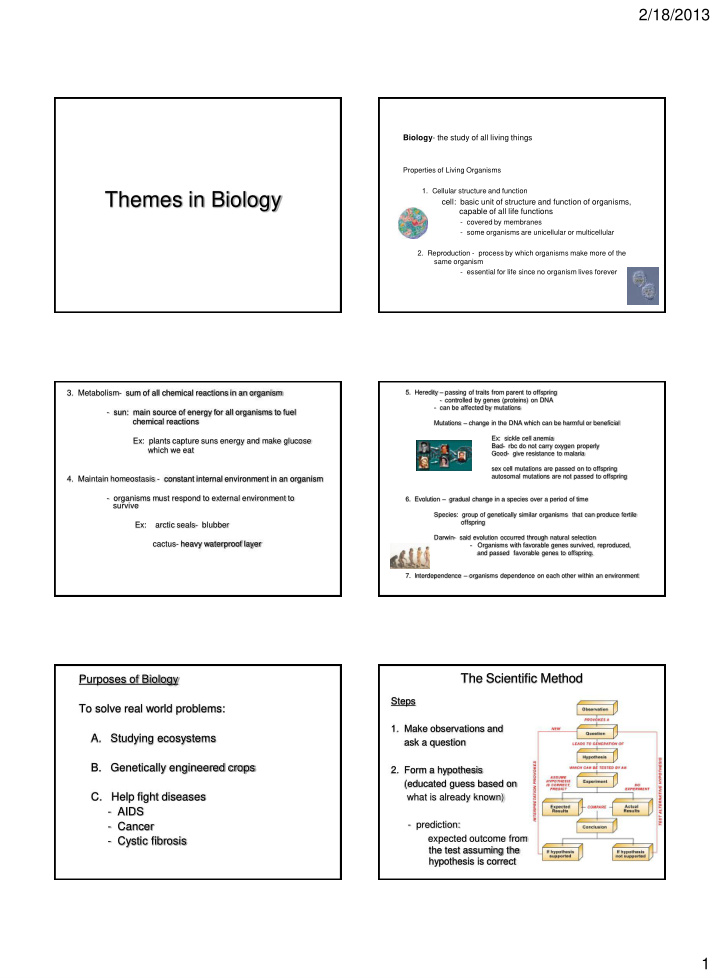



2/18/2013 Biology - the study of all living things Properties of Living Organisms 1. Cellular structure and function Themes in Biology cell: basic unit of structure and function of organisms, capable of all life functions - covered by membranes - some organisms are unicellular or multicellular 2. Reproduction - process by which organisms make more of the same organism - essential for life since no organism lives forever 5. Heredity – passing of traits from parent to offspring 3. Metabolism- sum of all chemical reactions in an organism - controlled by genes (proteins) on DNA - can be affected by mutations - sun: main source of energy for all organisms to fuel chemical reactions Mutations – change in the DNA which can be harmful or beneficial Ex: sickle cell anemia Ex: plants capture suns energy and make glucose Bad- rbc do not carry oxygen properly which we eat Good- give resistance to malaria sex cell mutations are passed on to offspring autosomal mutations are not passed to offspring 4. Maintain homeostasis - constant internal environment in an organism - organisms must respond to external environment to 6. Evolution – gradual change in a species over a period of time survive Species: group of genetically similar organisms that can produce fertile offspring Ex: arctic seals- blubber Darwin- said evolution occurred through natural selection cactus- heavy waterproof layer - Organisms with favorable genes survived, reproduced, and passed favorable genes to offspring. 7. Interdependence – organisms dependence on each other within an environment The Scientific Method Purposes of Biology Steps To solve real world problems: 1. Make observations and A. Studying ecosystems ask a question B. Genetically engineered crops 2. Form a hypothesis (educated guess based on C. Help fight diseases what is already known) - AIDS - prediction: - Cancer expected outcome from - Cystic fibrosis the test assuming the hypothesis is correct 1
2/18/2013 3. Test the hypothesis thru 4. Collect and analyze data experimentation - use charts, tables, observations - controlled experiment A. control group: 5. Draw conclusions “normal condition” (formation of a theory) - receives no experimental treatment or change in - can support or reject condition hypothesis B. experimental group: “test group” - can be disproven - variable/ experimental factor through further being tested for experimentation a. independent variable: 6. Share results or retest factor being varied - publish data in scientific b. dependant variable: journals factor being measured Pie Charts Representing Data Graphically Charts/Graphs There are three basic components to most charts/graphs: • Labels- defines the data: - title, axis titles and labels, legends defining separate data series • Scales- define the range of the Y and the X axis • Graphical elements- represent the data - bars in bar charts - lines in times series plot - points in scatter plots - slices of a pie chart Line Graphs Bar Graphs School System Enrollment 2
2/18/2013 Scatter Plots (x,y) Scatter Plots (x,y) Rules for Scatterplots (shows relationship between variables) • Use two interval-level variables (x and y) • Fully define the variables with the axis titles • Chart title should identify the two variables and the cases (e.g., cities or states) • X axis: independent variable (cause) Y axis: dependent variable (result) • Scale the axes to maximize the use of the plot area for displaying the data points • Use same interval measurements on each axis • Do NOT connect dots, use a trend line Scatter Plot Trend Lines Theory - Explanation based on a set of related hypotheses that have been tested and confirmed many times but can be broken. NEGATIVE indirect - Theories unite and explain a broad range of relationship (+, -) observations - Scientific theories are generally accepted as scientific principle whereas to the general public, theories are considered statements of uncertainty NULL POSITIVE no direct relationship relationship (0,0) (+, +) Measurement Scientific Law summarizing statement that is considered fact and can not be broken Ex: gravity “Eventually we will have to exchange our feet for meters” 3
2/18/2013 Measurement • System International (SI) - standardized system of measurement - based on the number 10 - France, late 1700’s SI Prefixes 4
Recommend
More recommend